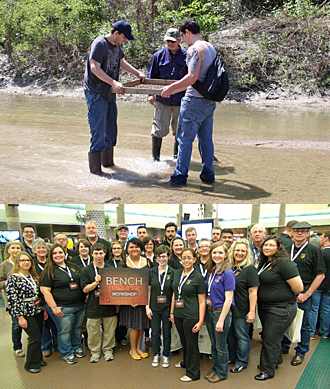PJC students find learning outside classroom
Published or Revised July 18, 2014
Searching for fossils in the North Sulphur River (top) are PJC student Marc Mercier of Roxton (left) and Forrest Lane of Honey Grove as PJC geology instructor Mike Barnett looks on. Students from PJC’s Texas Institute of Jewelry Technology, below, enjoyed visiting jewelry manufacturer Stuller, Inc., in Louisiana. Shown from left are (front row) Jessica Walla, Melissa Walden, Eric Fincher, Brittany Bean, Casey Farrell, Hannah Pinon, and Sarah Helliun; in the middle row are Sandi Downs with Alexander’s Jewelers, PJC jewelry instructor Shannon Calloway, David Limbough, Samatha Lamphier, Kersten Saffel, Norma Steadham, Deborah Smith, Charolette Speulda, Beverly Gilbert, and Angelica Guevara; in the back row are Ryan Petticrew with Stuller Inc., PJC jewelry assistant Gove Slate, Kerby Dewbre, Koa Haun, Toby Cavazos, Jory Wall, Jonathon DuBois, Ricardo Ruiz, William Bussell, and Ken Edmunson. Not pictured but also attending were Olivia Sharp and Jonathon Newton.
Not all lessons for Paris Junior College students are taught in the classrooms, as both jewelry and science course students found out last semester. For both disciplines, students were able to bring back insights from the field.
A treasure hunt of sorts was on tap for PJC biology and geology students when they went looking for fossils along the North Sulphur River. That location provides outstanding opportunities to find shallow Marine Cretaceous fossils. Upper layers in the banks contain Pleistocene fossils such as mammoth teeth and bones.
Led by PJC biology instructor Jack Brown and geology instructor Mike Barnett, the group found fossils such as exogyra ponderosa, sand shark teeth, enchodus teeth (a fish also known as a saber tooth herring), a mososaur tooth, gastropod fossils, and exogyra costata, (saltwater oysters).
The majors’ biology class went into detail on geologic history, evolutionary theory and the process of fossilization. The geology class also covered geological time periods and fossilization. Students from both classes learned by visiting the nearby location that the area was a shallow sea 90 million years ago.
“We have many fossils of extinct marine creatures that lived in shallow seas,” said Brown. “You can see the layers of time in the banks of the river and even see when they went extinct. The layers the marine creatures are in wash out, but many are still buried in the sides of the banks so you can dig in and find marine fossils from 90-70 million years ago. It is a wonderful way to get students to comprehend deep time and the changes that have occurred in the planet’s history.”
Attending a jeweler’s workshop at Stuller, Inc., in Lafayette, Louisiana, was a big plus PJC’s Texas Institute of Jewelry Technology students. Stuller is the largest jewelry manufacturer in America.
“It was an amazing experience to be able to meet and network with professionals face to face in the largest jewelry manufacturing business in America,” said jewelry student association event coordinator Ricardo Ruiz. “PJC students were able to make many contacts for their future careers.”
Attendees were taken on a tour of the facilities, attended classes and interactive demonstrations as well as a tool sale. The trip left students excited and ready to get back to the bench to try all the new techniques they learned.

